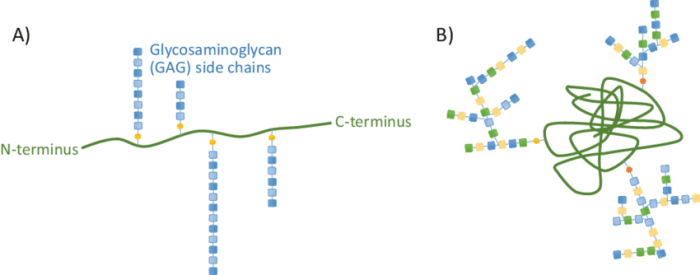Classify each characteristic as describing glycoproteins or proteoglycans. Delve into the fascinating world of glycoproteins and proteoglycans, two essential biomolecules that play pivotal roles in various biological processes. This exploration will unveil their structural intricacies, functional significance, and the distinctive features that set them apart.
Glycoproteins, adorned with sugar chains, and proteoglycans, characterized by their glycosaminoglycan chains, exhibit unique properties and biological functions. Embark on a journey to decipher their characteristics and comprehend the remarkable contributions they make to the symphony of life.
Classification of Glycoproteins and Proteoglycans: Classify Each Characteristic As Describing Glycoproteins Or Proteoglycans.

Glycoproteins and proteoglycans are two types of molecules that are composed of proteins and carbohydrates. They differ in their structure and function.
Structural Differences
- Glycoproteins:Glycoproteins are proteins that have carbohydrate groups attached to them. The carbohydrate groups can be either simple sugars or complex oligosaccharides.
- Proteoglycans:Proteoglycans are proteins that have glycosaminoglycan (GAG) chains attached to them. GAGs are long, unbranched polysaccharides that are composed of repeating units of disaccharides.
Characteristics of Glycoproteins
Glycoproteins are found in all cells and tissues of the body. They play a variety of roles, including:
- Cell-cell adhesion:Glycoproteins help cells to adhere to each other and to the extracellular matrix.
- Signal transduction:Glycoproteins can bind to specific receptors on the surface of cells and trigger a signal transduction cascade.
- Immune response:Glycoproteins are involved in the immune response by helping to identify and destroy foreign invaders.
Glycoproteins are composed of a protein backbone and one or more carbohydrate groups. The carbohydrate groups can be either simple sugars or complex oligosaccharides. The type of carbohydrate group that is attached to a glycoprotein determines its function.
Some examples of glycoproteins include:
- Immunoglobulins:Immunoglobulins are glycoproteins that are produced by the immune system to fight infection.
- Hormones:Hormones are glycoproteins that are produced by endocrine glands to regulate various body functions.
- Enzymes:Enzymes are glycoproteins that catalyze chemical reactions in the body.
Characteristics of Proteoglycans, Classify each characteristic as describing glycoproteins or proteoglycans.
Proteoglycans are found in the extracellular matrix of all tissues. They play a variety of roles, including:
- Structural support:Proteoglycans provide structural support to the extracellular matrix.
- Water retention:Proteoglycans are able to hold large amounts of water, which helps to keep tissues hydrated.
- Cell-cell interactions:Proteoglycans can bind to specific receptors on the surface of cells and regulate cell-cell interactions.
Proteoglycans are composed of a protein backbone and one or more GAG chains. The GAG chains are long, unbranched polysaccharides that are composed of repeating units of disaccharides. The type of GAG chain that is attached to a proteoglycan determines its function.
Some examples of proteoglycans include:
- Hyaluronic acid:Hyaluronic acid is a proteoglycan that is found in the extracellular matrix of all tissues. It provides structural support and helps to keep tissues hydrated.
- Chondroitin sulfate:Chondroitin sulfate is a proteoglycan that is found in the extracellular matrix of cartilage. It provides structural support and helps to protect cartilage from damage.
- Heparan sulfate:Heparan sulfate is a proteoglycan that is found in the extracellular matrix of all tissues. It helps to regulate cell-cell interactions and plays a role in the immune response.
Comparison of Glycoproteins and Proteoglycans
| Characteristic | Glycoproteins | Proteoglycans |
|---|---|---|
| Structure | Protein backbone with one or more carbohydrate groups attached | Protein backbone with one or more GAG chains attached |
| Function | Cell-cell adhesion, signal transduction, immune response | Structural support, water retention, cell-cell interactions |
| Location | All cells and tissues | Extracellular matrix of all tissues |
Glycoproteins and proteoglycans are two important types of molecules that play a variety of roles in the body. They differ in their structure, function, and location.
Answers to Common Questions
What is the primary structural difference between glycoproteins and proteoglycans?
Glycoproteins are characterized by their covalent attachment to oligosaccharides, while proteoglycans are distinguished by their glycosaminoglycan chains, which are attached to a core protein via a linkage region.
How do glycoproteins contribute to cell signaling?
Glycoproteins often serve as receptors or ligands, facilitating the transmission of signals between cells and mediating cellular responses.
What role do proteoglycans play in regulating cell growth?
Proteoglycans can modulate cell growth by influencing the availability of growth factors and regulating the interactions between cells and the extracellular matrix.

